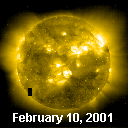|   SPACE WEATHER SPACE WEATHER
Current
Conditions
Solar Wind
velocity: 395.1 km/s
density:1.9 protons/cm3
explanation | more data
Updated: Today at 2246 UT
X-ray Solar Flares
6-hr max: C1 2010 UT Feb10
24-hr: C3 2320 UT Feb09
explanation | more data
Updated: Today at 2245 UT
Daily Sun: 10 Feb '01 
All of the numbered sunspots in this SOHO white light image have relatively uncomplicated beta-class magnetic fields. Sunspots 9338 and 9345, which are rapidly growing, might soon develop complicated field geometries that would harbor energy for powerful solar flares.
Sunspot Number: 179
More about sunspots
Updated: 09 Feb 2001
Radio Meteor Rate
24 hr max: 32 per hr
Listen to the Meteor Radar!
Updated: 10 Feb 2001 Interplanetary Mag. Field
Btotal: 5.7 nT
Bz: 0.6 nT south
explanation | more data
Updated: Today at 2247 UT Coronal Holes:

There are no substantial coronal holes indicated in this extreme UV image of the Sun. Image credit: SOHO Extreme UV Telescope.
More about coronal holes
 SPACE WEATHER SPACE WEATHER
NOAA
Forecasts
Solar Flares: Probabilities for a medium-sized (M-class) or a major (X-class) solar flare during the next 24/48 hours are tabulated below.
Updated at 2001 Feb 10 2200 UT
| FLARE | 24 hr | 48 hr | | CLASS M | 10 % | 10 % | | CLASS X | 01 % | 01 % |
Geomagnetic Storms: Probabilities for significant disturbances in Earth's magnetic field are given for three activity levels: active, minor storm, severe storm
Updated at 2001 Feb 10 2200 UT Mid-latitudes | 24 hr | 48 hr | | ACTIVE | 10 % | 10 % | | MINOR | 05 % | 05 % | | SEVERE | 01 % | 01 % |
High latitudes | 24 hr | 48 hr | | ACTIVE | 15 % | 15 % | | MINOR | 10 % | 10 % | | SEVERE | 05 % | 05 % |
| What's Up in Space -- 10 Feb 2001
Subscribe to Space Weather News! FAST-GROWING SUNSPOTS: Solar activity has been remarkably low for the past three days, but that could change with the rapid emergence of a new sunspot complex. Active regions 9345 and 9338, which were nearly invisible just two days ago, are now among the largest spots on the solar disk. Rapidly changing magnetic fields above these active regions pose a threat for solar flares.  Above: This 48-hour animation of SOHO white light images shows the meteoric growth of sunspots 9345 and 9338 on Jan. 8th and 9th. ASTEROID FLYBY: Near-Earth asteroid 2001 WO148 will fly by our planet February 15th at 15:28 GMT. At closest approach the 400-meter wide space rock will be 65 lunar distances from Earth -- there is no threat of a collision. [see the 3D orbit] WEB LINKS: NOAA FORECAST | GLOSSARY | SPACE WEATHER TUTORIAL | LESSON PLANS | MORE NEWS | BECOME A SUBSCRIBER |
 - TOTAL LUNAR ECLIPSE: On Jan. 9, 2001, the full Moon glided through Earth's copper-colored shadow. [gallery]
- CHRISTMAS ECLIPSE: Sky watchers across North America enjoyed a partial solar eclipse on Christmas Day 2000 [gallery]
- LEONIDS 2000: Observers around the globe enjoyed three predicted episodes of shooting stars. [gallery]
 | On January 19th the University of Arizona Spacewatch program spotted a new Earth-approaching asteroid, 2001 BK41. The ~3 km-wide space rock, which follows a 2.8 year orbit stretching from the inner solar system (between Earth and Venus) to the asteroid belt, poses no immediate threat. Our next close encounter with 2001 BK41 will take place in 2094 when it passes 8 lunar distances from Earth. If current orbital calculations are correct, the asteroid can never come closer than 6 lunar distances from our planet. [3D orbit] |  Jan. 25, 2001: Earth's Invisible Magnetic Tail -- NASA's IMAGE spacecraft, the first to enjoy a global view of the magnetosphere, spotted a curious plasma tail pointing from Earth toward the Sun. Jan. 4, 2001: Earth at Perihelion -- On January 4, 2001, our planet made its annual closest approach to the Sun. Dec. 29, 2000: Millennium Meteors -- North Americans will have a front-row seat for a brief but powerful meteor shower on January 3, 2001. Dec. 28, 2000: Galileo Looks for Auroras on Ganymede -- NASA's durable Galileo spacecraft flew above the solar system's largest moon this morning in search of extraterrestrial "Northern Lights" Dec. 22, 2000: Watching the Angry Sun -- Solar physicists are enjoying their best-ever look at a Solar Maximum thanks to NOAA and NASA satellites. Dec. 18, 2000: Ursid Meteor Surprise -- The normally meek Ursid meteor shower could surprise sky watchers with a powerful outburst on Dec 22nd. Dec. 8, 2000: The Baffling Geminid Meteor Shower -- Most meteor showers are caused by comets, but the Geminids, which peak on December 13th, seem to come from a curious near-Earth asteroid. Nov. 22, 2000: A Solar Flare Stuns Stardust -- Earlier this month an intense solar radiation storm temporarily blinded NASA's Stardust spacecraft en route to comet Wild-2. Nov. 21, 2000: Leonids Galore -- Find out what happened during the 2000 Leonids meteor shower. Nov. 7, 2000: Much Ado about 2000 SG344 -- In 2071 a relic of NASA's earliest space exploration efforts might return to Earth, if current estimates are confirmed. Oct. 26, 2000: Lunar Leonids -- On Nov. 17, 2000, the moon will plow through a stream of debris from comet Tempel-Tuttle. Oct. 10, 2000: The Moonlit Leonids 2000 -- Our planet is heading for a minefield of cosmic dust streams laid down by periodic comet Tempel-Tuttle. The result could be a series of meteor outbursts on Nov. 17 and 18, 2000. MORE SPACE WEATHER HEADLINES |



